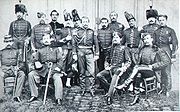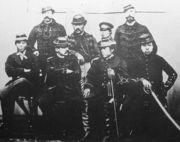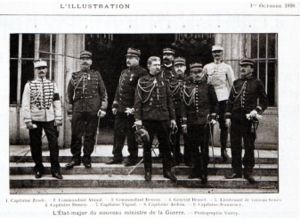
Jules Brunet
Encyclopedia
Jules Brunet was a French
officer who played an active role in Mexico
and Japan
, and later became a General and Chief of Staff of the French Minister of War in 1898. He was sent to Japan
with the French military mission of 1867, and after the defeat of the Shogun
, had an important role in the latter part of Boshin War
between the Imperial forces and the Shogun's army.
, in the Franche-Comté
region of eastern France. He graduated from the École Polytechnique
in 1857, where he specialized in artillery
.
Brunet participated in the French intervention in Mexico
(1862–1867), and received the Légion d'honneur
.
sent a group of military advisors to Japan
to help modernize the Shogun's army. Brunet was sent as an artillery instructor. The mission arrived in early 1867, and trained the Shogun's troops for about a year.
Then in 1868, the Shogun was overthrown in the Boshin War
, and Emperor Meiji
was nominally restored
to full power. The French military mission was then ordered to leave Japan by Imperial decree.
 However, Brunet chose to remain. He resigned from the French army, and left for the north of Japan with the remains of the Shogunate's armies in the hope of staging a counter-attack. In a letter to Napoleon III, Brunet explained the plan of the Alliance, as well as his role in it:
However, Brunet chose to remain. He resigned from the French army, and left for the north of Japan with the remains of the Shogunate's armies in the hope of staging a counter-attack. In a letter to Napoleon III, Brunet explained the plan of the Alliance, as well as his role in it:
 Brunet took a very active role in the Boshin War. Brunet and Captain André Cazeneuve were present at the Battle of Toba-Fushimi
Brunet took a very active role in the Boshin War. Brunet and Captain André Cazeneuve were present at the Battle of Toba-Fushimi
(27–31 January 1868), near Osaka. After that Imperial victory, Brunet, Cazeneuve, and the Shogun's Admiral, Enomoto Takeaki
, fled to Edo (now Tokyo
) on the warship Fujisan
.
When Edo also fell to the Imperial forces, Enomoto and Brunet fled to the northern island of Hokkaidō
, where they proclaimed the Ezo Republic, with Enomoto as President. Brunet helped organize the Ezo army, under hybrid Franco-Japanese leadership. Otori Keisuke was Commander-in-chief, and Brunet was second in command. Each of the four brigades were commanded by a French officer (Fortant
, Marlin
, Cazeneuve, and Bouffier
), with Japanese officers commanding each half-brigade.
The final stand of the Shogun/Ezo forces was the Battle of Hakodate
. The Ezo forces, numbering 800, were defeated by 8,000 Imperial troops.
In an interesting postscript to his involvement in the Boshin War, Brunet spoke highly of Shinsengumi vice-commander Hijikata Toshizō
in his memoirs. Praising Hijikata's ability as a leader, he said that if the man had been in Europe, he most certainly would have been a general.
 Brunet and the other French advisers were wanted by the Imperial government. But
Brunet and the other French advisers were wanted by the Imperial government. But
they were evacuated from Hokkaidō, by a French warship (the corvette Coëtlogon, commanded by Dupetit-Thouars
), and then taken to Saigon by the Dupleix
. Brunet now returned to France.
The new Japanese government requested that Brunet be punished for his activities in the Boshin War. But his actions had won popular support in France, and the request was denied.
Instead, he was quickly rehabilitated and rejoined the French army. During the Franco-Prussian War
of 1870-1871, he was taken prisoner at the Siege of Metz
. After the war, he played a key role as a member of the Versailles Army in the suppression of the Paris Commune
in 1871.
. Through Enomoto's influence, the Imperial government not only forgave Brunet's actions, but awarded him medals in May 1881 and again in March 1885. The medal were presented at the Japanese Embassy in Paris
.
 Brunet rose to the rank of General in the French army over the next 17 years. In 1898, Chanoine, his former senior officer in the Japan mission, was Minister of War, and Brunet became his Chief of Staff ("Chef de l'état-major du ministre de la Guerre").
Brunet rose to the rank of General in the French army over the next 17 years. In 1898, Chanoine, his former senior officer in the Japan mission, was Minister of War, and Brunet became his Chief of Staff ("Chef de l'état-major du ministre de la Guerre").
His actions partially inspired the character of Captain Nathan Algren in the 2003 movie The Last Samurai
.
France
The French Republic , The French Republic , The French Republic , (commonly known as France , is a unitary semi-presidential republic in Western Europe with several overseas territories and islands located on other continents and in the Indian, Pacific, and Atlantic oceans. Metropolitan France...
officer who played an active role in Mexico
Mexico
The United Mexican States , commonly known as Mexico , is a federal constitutional republic in North America. It is bordered on the north by the United States; on the south and west by the Pacific Ocean; on the southeast by Guatemala, Belize, and the Caribbean Sea; and on the east by the Gulf of...
and Japan
Japan
Japan is an island nation in East Asia. Located in the Pacific Ocean, it lies to the east of the Sea of Japan, China, North Korea, South Korea and Russia, stretching from the Sea of Okhotsk in the north to the East China Sea and Taiwan in the south...
, and later became a General and Chief of Staff of the French Minister of War in 1898. He was sent to Japan
with the French military mission of 1867, and after the defeat of the Shogun
Shogun
A was one of the hereditary military dictators of Japan from 1192 to 1867. In this period, the shoguns, or their shikken regents , were the de facto rulers of Japan though they were nominally appointed by the emperor...
, had an important role in the latter part of Boshin War
Boshin War
The was a civil war in Japan, fought from 1868 to 1869 between forces of the ruling Tokugawa shogunate and those seeking to return political power to the imperial court....
between the Imperial forces and the Shogun's army.
Early life
Brunet was born in BelfortBelfort
Belfort is a commune in the Territoire de Belfort department in Franche-Comté in northeastern France and is the prefecture of the department. It is located on the Savoureuse, on the strategically important natural route between the Rhine and the Rhône – the Belfort Gap or Burgundian Gate .-...
, in the Franche-Comté
Franche-Comté
Franche-Comté the former "Free County" of Burgundy, as distinct from the neighbouring Duchy, is an administrative region and a traditional province of eastern France...
region of eastern France. He graduated from the École Polytechnique
École Polytechnique
The École Polytechnique is a state-run institution of higher education and research in Palaiseau, Essonne, France, near Paris. Polytechnique is renowned for its four year undergraduate/graduate Master's program...
in 1857, where he specialized in artillery
Artillery
Originally applied to any group of infantry primarily armed with projectile weapons, artillery has over time become limited in meaning to refer only to those engines of war that operate by projection of munitions far beyond the range of effect of personal weapons...
.
Brunet participated in the French intervention in Mexico
French intervention in Mexico
The French intervention in Mexico , also known as The Maximilian Affair, War of the French Intervention, and The Franco-Mexican War, was an invasion of Mexico by an expeditionary force sent by the Second French Empire, supported in the beginning by the United Kingdom and the Kingdom of Spain...
(1862–1867), and received the Légion d'honneur
Légion d'honneur
The Legion of Honour, or in full the National Order of the Legion of Honour is a French order established by Napoleon Bonaparte, First Consul of the Consulat which succeeded to the First Republic, on 19 May 1802...
.
Arrival in Japan
Napoleon IIINapoleon III of France
Louis-Napoléon Bonaparte was the President of the French Second Republic and as Napoleon III, the ruler of the Second French Empire. He was the nephew and heir of Napoleon I, christened as Charles Louis Napoléon Bonaparte...
sent a group of military advisors to Japan
French Military Mission to Japan (1867)
The French Military Mission to Japan of 1867-68 was the first foreign military training mission to Japan. The mission was formed by Napoléon III, following a request of the Japanese Shogunate in the person of its emissary to Europe, Shibata Takenaka .Shibata was already negotiating the final...
to help modernize the Shogun's army. Brunet was sent as an artillery instructor. The mission arrived in early 1867, and trained the Shogun's troops for about a year.
Then in 1868, the Shogun was overthrown in the Boshin War
Boshin War
The was a civil war in Japan, fought from 1868 to 1869 between forces of the ruling Tokugawa shogunate and those seeking to return political power to the imperial court....
, and Emperor Meiji
Emperor Meiji
The or was the 122nd emperor of Japan according to the traditional order of succession, reigning from 3 February 1867 until his death...
was nominally restored
Meiji Restoration
The , also known as the Meiji Ishin, Revolution, Reform or Renewal, was a chain of events that restored imperial rule to Japan in 1868...
to full power. The French military mission was then ordered to leave Japan by Imperial decree.

The Boshin War

Battle of Toba-Fushimi
The occurred between pro-Imperial and Tokugawa shogunate forces during the Boshin War in Japan. The battle started on 27 January 1868 , when the forces of the Tokugawa shogunate and the allied forces of Chōshū, Satsuma and Tosa domains clashed near Fushimi...
(27–31 January 1868), near Osaka. After that Imperial victory, Brunet, Cazeneuve, and the Shogun's Admiral, Enomoto Takeaki
Enomoto Takeaki
Viscount was a samurai and admiral of the Tokugawa navy of Bakumatsu period Japan, who remained faithful to the Tokugawa shogunate who fought against the new Meiji government until the end of the Boshin War...
, fled to Edo (now Tokyo
Tokyo
, ; officially , is one of the 47 prefectures of Japan. Tokyo is the capital of Japan, the center of the Greater Tokyo Area, and the largest metropolitan area of Japan. It is the seat of the Japanese government and the Imperial Palace, and the home of the Japanese Imperial Family...
) on the warship Fujisan
Japanese warship Fujisan
The was a Japanese steam frigate of the Bakufu Navy. She was built in New York, USA, in 1864, and was acquired by the Bakufu on April 28, 1868. She was equipped with side wheels for propulsion, and a gun in the bows, a design which was already obsolescent at that time.She was one of the four ships...
.
When Edo also fell to the Imperial forces, Enomoto and Brunet fled to the northern island of Hokkaidō
Hokkaido
, formerly known as Ezo, Yezo, Yeso, or Yesso, is Japan's second largest island; it is also the largest and northernmost of Japan's 47 prefectural-level subdivisions. The Tsugaru Strait separates Hokkaido from Honshu, although the two islands are connected by the underwater railway Seikan Tunnel...
, where they proclaimed the Ezo Republic, with Enomoto as President. Brunet helped organize the Ezo army, under hybrid Franco-Japanese leadership. Otori Keisuke was Commander-in-chief, and Brunet was second in command. Each of the four brigades were commanded by a French officer (Fortant
Arthur Fortant
Arthur Fortant was a non-commissioned officer, a sergeant of the French Regiment of the Guard of the field artillery. He was a member of the first French Military Mission to Japan in 1867, in which he accompanied Jules Brunet...
, Marlin
Jean Marlin
Jean Marlin was a non-commissioned officer, a sergeant of the French 8th Battalion of infantry. He was a member of the first French Military Mission to Japan in 1867, in which he accompanied Jules Brunet...
, Cazeneuve, and Bouffier
François Bouffier
François Bouffier was a French non-commissioned officer of the 19th century, a sergeant of the 8th Battalion of infantrymen. He was a member of the first French Military Mission to Japan in 1867, in which he accompanied Jules Brunet...
), with Japanese officers commanding each half-brigade.
The final stand of the Shogun/Ezo forces was the Battle of Hakodate
Battle of Hakodate
The was fought in Japan from October 20, 1868 to May 17, 1869, between the remnants of the Tokugawa shogunate army, consolidated into the armed forces of the rebel Ezo Republic, and the armies of the newly formed Imperial government...
. The Ezo forces, numbering 800, were defeated by 8,000 Imperial troops.
In an interesting postscript to his involvement in the Boshin War, Brunet spoke highly of Shinsengumi vice-commander Hijikata Toshizō
Hijikata Toshizo
was the vice-commander of Shinsengumi, a great swordsman and a talented Japanese military leader who resisted the Meiji Restoration.-Background:...
in his memoirs. Praising Hijikata's ability as a leader, he said that if the man had been in Europe, he most certainly would have been a general.
Return to France

they were evacuated from Hokkaidō, by a French warship (the corvette Coëtlogon, commanded by Dupetit-Thouars
Abel Dupetit-Thouars
Abel-Nicolas Georges Henri Bergasse Dupetit Thouars was a French sailor, vice-admiral, saver of Lima and a hero in Peru.He was born in Bordeaux-en-Gâtinais, Loiret...
), and then taken to Saigon by the Dupleix
FS Dupleix (1861)
The Dupleix was a steam and sail corvette of the French Marine Nationale. She was the first French vessel named after the 18th Century Governor of Pondichéry and Gouverneur Général of the French possessions in India marquess Joseph François Dupleix.After her commissioning, the Dupleix was sent to...
. Brunet now returned to France.
The new Japanese government requested that Brunet be punished for his activities in the Boshin War. But his actions had won popular support in France, and the request was denied.
Instead, he was quickly rehabilitated and rejoined the French army. During the Franco-Prussian War
Franco-Prussian War
The Franco-Prussian War or Franco-German War, often referred to in France as the 1870 War was a conflict between the Second French Empire and the Kingdom of Prussia. Prussia was aided by the North German Confederation, of which it was a member, and the South German states of Baden, Württemberg and...
of 1870-1871, he was taken prisoner at the Siege of Metz
Siege of Metz
The Siege of Metz lasting from 19 August – 27 October 1870 was fought during the Franco-Prussian War and ended in a decisive Prussian victory.-History:...
. After the war, he played a key role as a member of the Versailles Army in the suppression of the Paris Commune
Paris Commune
The Paris Commune was a government that briefly ruled Paris from March 18 to May 28, 1871. It existed before the split between anarchists and Marxists had taken place, and it is hailed by both groups as the first assumption of power by the working class during the Industrial Revolution...
in 1871.
Rehabilitation in Japan
Brunet's former ally, Admiral Enomoto, had joined the Imperial government and became Minister of the Imperial Japanese NavyImperial Japanese Navy
The Imperial Japanese Navy was the navy of the Empire of Japan from 1869 until 1947, when it was dissolved following Japan's constitutional renunciation of the use of force as a means of settling international disputes...
. Through Enomoto's influence, the Imperial government not only forgave Brunet's actions, but awarded him medals in May 1881 and again in March 1885. The medal were presented at the Japanese Embassy in Paris
Paris
Paris is the capital and largest city in France, situated on the river Seine, in northern France, at the heart of the Île-de-France region...
.
Later career

His actions partially inspired the character of Captain Nathan Algren in the 2003 movie The Last Samurai
The Last Samurai
The Last Samurai is a 2003 American epic drama film directed and co-produced by Edward Zwick, who also co-wrote the screenplay based on a story by John Logan. The film was inspired by a project developed by writer and director Vincent Ward, who had previously filmed the movie in 1990, starring...
.
Drawing and paintings by Jules Brunet
Brunet was a talented painter who left numerous depictions of his travels in Mexico and Japan.See also
- Franco-Japanese relationsFranco-Japanese relationsFrance-Japan relations refers to bilateral relations between France and Japan. The history of goes back to the early 17th century, when a Japanese samurai and ambassador on his way to Rome landed for a few days in Southern France, creating a sensation...
- The Last SamuraiThe Last SamuraiThe Last Samurai is a 2003 American epic drama film directed and co-produced by Edward Zwick, who also co-wrote the screenplay based on a story by John Logan. The film was inspired by a project developed by writer and director Vincent Ward, who had previously filmed the movie in 1990, starring...
- Naval Battle of HakodateNaval Battle of HakodateThe was fought from 4–10 May 1869, between the remnants of the Tokugawa shogunate navy, consolidated into the armed forces of the rebel Ezo Republic, and the newly formed Imperial Japanese Navy...

